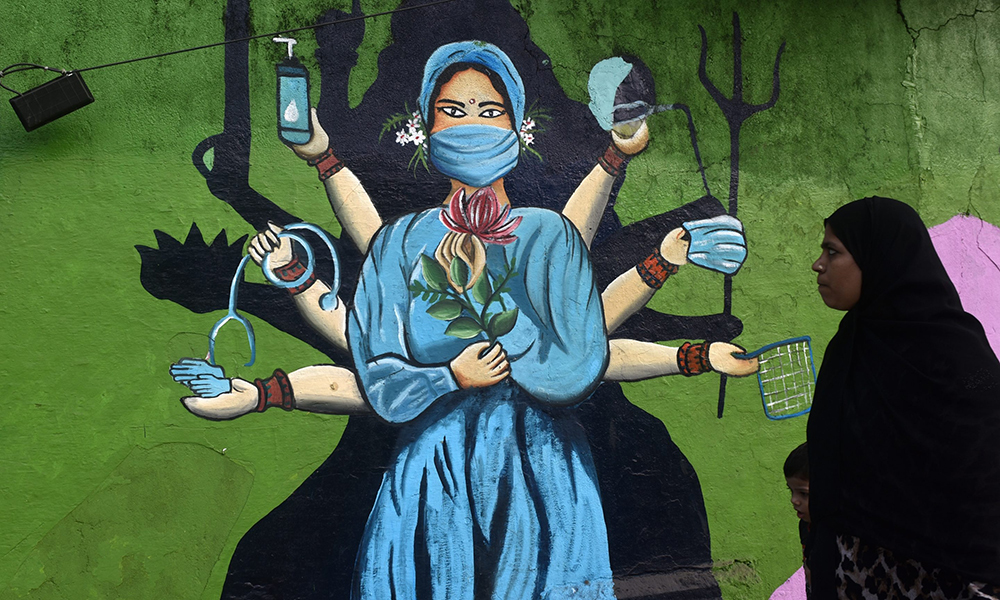高度突变的新冠变异株“Pirola” JN.1正在全球蔓延,全球死亡人数不断上升

世界卫生组织(World Health Organization)在上周表示,由于高度突变的新冠变异株“Pirola” JN.1的后代在美国和其他地方不断繁殖,导致的感染病例数也开始上升。2023年12月,全球新冠肺炎死亡病例达近1万例。
世界卫生组织的总干事谭德塞(Tedros Adhanom Ghebreyesus)于今年1月10日在日内瓦举行的新闻发布会上说,正如预期的那样,这波全球疫情浪潮发生在节假日聚会之后,而且正值JN.1变异株在全球占据主导地位。
谭德塞表示,与2023年11月相比,12月报告的新冠住院人数增加了42%,重症监护室住院人数增加了62%。
他补充道,这些数字肯定被低估了。这是因为全球只有四分之一的国家仍然在向世界卫生组织提供新冠感染病例数据——193个国家中只有不到50个国家,其中大部分位于欧洲和美洲。
他说:“虽然每月新冠死亡病例达1万例,但依然远低于疫情高峰期,这种可预防死亡的水平是不可接受的。”
“Pirola” JN.1变异株不断繁殖,导致的感染病例数急剧上升
全球趋势反映了美国的情况,根据美国疾病控制与预防中心(U.S. Centers for Disease Control and Prevention)的数据,截至2023年12月30日,美国新冠死亡人数每周增加12.5%,住院人数增加20%以上。
美国疾病控制与预防中心的最新预测显示,JN.1变异株在美国也占据主导地位,截至1月6日,JN.1感染病例估计占病例总数的62%。
据位于美国阿肯色州琼斯伯勒的纽约理工学院(New York Institute of Technology)的研究助理院长兼副教授、新冠变异株追踪专家拉杰·拉杰纳拉亚南称,这种高度突变的新冠变异株“Pirola” JN.1正在不断繁殖,导致感染病例数上升。
拉杰纳拉亚南对《财富》杂志表示,根据追踪新冠病毒和流感病毒变化的国际研究机构全球共享流感数据倡议组织(GISAID)的数据,JN.1.4,可以说是JN.1的“后代”,是1月11日美国报告的第三大最常见变异株,占序列的11.5%。
他补充道,该病毒占全球序列的11%。
一些专家指出,“Pirola” JN.1可能是新冠疫情新篇章的开端,在一段时间内,所有主要变异株都可能由它演化而来。拉杰纳拉亚南称,即将出现的变异株——已经发现了33个亚系——很可能会携带额外的突变,而这些突变很有可能有助于病毒演化。
他补充道,JN.1.6.1包含突变“刺突R346T”,而JN.1不包含这种突变,该突变可能使其更具免疫逃避性。以前的一些变异株,例如BA.2.75.2、BA.4.6、BQ.1.1和XBB.1也包含这种突变。
“在可预见的未来,JN.1及其后代将继续主导全球格局。”杰伊·韦兰告诉《财富》杂志。他是一名以准确率高而闻名的变异株预测者,也是为数不多仍然留在该行业的人之一。
另一种新冠变异株“克拉肯”(Kraken) XBB.1.5于2023年1月在美国达到了感染峰值,当时是美国感染病例第二高的新冠变异株。韦兰表示,其后代将继续以低水平流行。
他补充道:“XBB谱系是否会完全灭绝,或者它们是否能够发生突变,从而在全球变异株库中保持一定的份额,还有待观察。”
韦兰和拉杰纳拉亚南认为,也有可能出现另一种BA.2.86的后代,比如JN.2,最终会崛起——就像最初的奥密克戎(BA.1)一样也曾经短暂达到峰值,但BA.2“隐形奥密克戎”系最终占据主导地位。
根据废水检测数据,韦兰预测美国的这波疫情浪潮已经达到峰值,很快就会见顶。今年冬天的这波疫情浪潮是美国迄今为止第二高的,截至1月9日,估计每21个美国人中就有1人感染。它打破了2023年1月XBB.1.5带来的感染峰值,使得其在该国疫情浪潮排行榜上屈居第三位。
但加拿大安大略省圭尔夫大学(University of Guelph)的生物学教授、主要变异株追踪专家瑞安·格雷戈里对《财富》杂志表示,现在还不是松一口气的时候。
他认为,人们关注的从来就不只是JN.1变异株本身,就像人们关注的从来不是BA.2.86(JN.1的母代谱系)本身一样。
格雷戈里称:“这与任何一个变异株都无关。这是关于不断演变的谱系的问题。”
他和其他变异株追踪者将BA.2.86、JN.1和所有病毒后代命名为“Pirola”家族。格雷戈里说:“只要它有充足的新宿主——也就是说,直到我们认真对待病毒力减弱问题,它会继续繁殖更多的亲属。”(财富中文网)
译者:中慧言-王芳
世界卫生组织(World Health Organization)在上周表示,由于高度突变的新冠变异株“Pirola” JN.1的后代在美国和其他地方不断繁殖,导致的感染病例数也开始上升。2023年12月,全球新冠肺炎死亡病例达近1万例。
世界卫生组织的总干事谭德塞(Tedros Adhanom Ghebreyesus)于今年1月10日在日内瓦举行的新闻发布会上说,正如预期的那样,这波全球疫情浪潮发生在节假日聚会之后,而且正值JN.1变异株在全球占据主导地位。
谭德塞表示,与2023年11月相比,12月报告的新冠住院人数增加了42%,重症监护室住院人数增加了62%。
他补充道,这些数字肯定被低估了。这是因为全球只有四分之一的国家仍然在向世界卫生组织提供新冠感染病例数据——193个国家中只有不到50个国家,其中大部分位于欧洲和美洲。
他说:“虽然每月新冠死亡病例达1万例,但依然远低于疫情高峰期,这种可预防死亡的水平是不可接受的。”
“Pirola” JN.1变异株不断繁殖,导致的感染病例数急剧上升
全球趋势反映了美国的情况,根据美国疾病控制与预防中心(U.S. Centers for Disease Control and Prevention)的数据,截至2023年12月30日,美国新冠死亡人数每周增加12.5%,住院人数增加20%以上。
美国疾病控制与预防中心的最新预测显示,JN.1变异株在美国也占据主导地位,截至1月6日,JN.1感染病例估计占病例总数的62%。
据位于美国阿肯色州琼斯伯勒的纽约理工学院(New York Institute of Technology)的研究助理院长兼副教授、新冠变异株追踪专家拉杰·拉杰纳拉亚南称,这种高度突变的新冠变异株“Pirola” JN.1正在不断繁殖,导致感染病例数上升。
拉杰纳拉亚南对《财富》杂志表示,根据追踪新冠病毒和流感病毒变化的国际研究机构全球共享流感数据倡议组织(GISAID)的数据,JN.1.4,可以说是JN.1的“后代”,是1月11日美国报告的第三大最常见变异株,占序列的11.5%。
他补充道,该病毒占全球序列的11%。
一些专家指出,“Pirola” JN.1可能是新冠疫情新篇章的开端,在一段时间内,所有主要变异株都可能由它演化而来。拉杰纳拉亚南称,即将出现的变异株——已经发现了33个亚系——很可能会携带额外的突变,而这些突变很有可能有助于病毒演化。
他补充道,JN.1.6.1包含突变“刺突R346T”,而JN.1不包含这种突变,该突变可能使其更具免疫逃避性。以前的一些变异株,例如BA.2.75.2、BA.4.6、BQ.1.1和XBB.1也包含这种突变。
“在可预见的未来,JN.1及其后代将继续主导全球格局。”杰伊·韦兰告诉《财富》杂志。他是一名以准确率高而闻名的变异株预测者,也是为数不多仍然留在该行业的人之一。
另一种新冠变异株“克拉肯”(Kraken) XBB.1.5于2023年1月在美国达到了感染峰值,当时是美国感染病例第二高的新冠变异株。韦兰表示,其后代将继续以低水平流行。
他补充道:“XBB谱系是否会完全灭绝,或者它们是否能够发生突变,从而在全球变异株库中保持一定的份额,还有待观察。”
韦兰和拉杰纳拉亚南认为,也有可能出现另一种BA.2.86的后代,比如JN.2,最终会崛起——就像最初的奥密克戎(BA.1)一样也曾经短暂达到峰值,但BA.2“隐形奥密克戎”系最终占据主导地位。
根据废水检测数据,韦兰预测美国的这波疫情浪潮已经达到峰值,很快就会见顶。今年冬天的这波疫情浪潮是美国迄今为止第二高的,截至1月9日,估计每21个美国人中就有1人感染。它打破了2023年1月XBB.1.5带来的感染峰值,使得其在该国疫情浪潮排行榜上屈居第三位。
但加拿大安大略省圭尔夫大学(University of Guelph)的生物学教授、主要变异株追踪专家瑞安·格雷戈里对《财富》杂志表示,现在还不是松一口气的时候。
他认为,人们关注的从来就不只是JN.1变异株本身,就像人们关注的从来不是BA.2.86(JN.1的母代谱系)本身一样。
格雷戈里称:“这与任何一个变异株都无关。这是关于不断演变的谱系的问题。”
他和其他变异株追踪者将BA.2.86、JN.1和所有病毒后代命名为“Pirola”家族。格雷戈里说:“只要它有充足的新宿主——也就是说,直到我们认真对待病毒力减弱问题,它会继续繁殖更多的亲属。”(财富中文网)
译者:中慧言-王芳
Nearly 10,000 COVID deaths occurred globally in December, the World Health Organization said this week—this as highly mutated variant “Pirola” JN.1 offspring spawn and begin their upward ascents in the U.S. and elsewhere.
The global wave occurs after holiday gatherings, as expected, and comes as JN.1 dominates worldwide, the organization’s director general, Tedros Adhanom Ghebreyesus, said at a January 10 news conference in Geneva.
Reported COVID hospitalizations increased by 42%, Ghebreyesus said, and ICU admissions by 62% in December, when compared to November.
The numbers are certainly underestimates, he added. That’s because only a quarter of the world’s countries are still providing COVID data to the WHO—less than 50 of 193 nations, most located in Europe and America.
“Although 10,000 deaths a month is far less than the peak of the pandemic, this level of preventable death is not acceptable,” he said.
“Pirola” JN.1 spawn take off
The global trends mirror those in the U.S., where COVID deaths were up 12.5% week-over-week and hospitalizations were up more than 20% as of Dec. 30, according to the U.S. Centers for Disease Control and Prevention.
In the U.S., too, JN.1 dominates, comprising an estimated 62% of cases as of Jan. 6, according to the latest CDC projections.
The highly mutated variant’s spawn are already climbing the charts, according to Raj Rajnarayanan—assistant dean of research and associate professor at the New York Institute of Technology campus in Jonesboro, Ark., and a top COVID variant tracker.
JN.1.4—a “child,” so to speak, of JN.1—was the No. 3 most commonly reported variant in the U.S. on January 11, comprising 11.5% of sequences, Rajnarayanan told Fortune, citing data from GISAID, an international research organization that tracks changes in COVID and the flu virus.
It’s responsible for 11% of sequences globally, he added.
“Pirola” JN.1 may be the beginning of a new chapter in the pandemic, some experts say, with potentially all major variants evolving from it for a time. Forthcoming variants—33 sublineages have been spotted already, Rajnarayanan said—are likely to pick up additional mutations that could very well help the virus.
JN.1.6.1 includes mutation “spike R346T,” which JN.1 doesn’t contain—one that could make it even more immune evasive, he added. Some previous variants like BA.2.75.2, BA.4.6, BQ.1.1, and XBB.1 also contained the mutation.
“JN.1 and its derivatives will continue to dominate the global landscape for the foreseeable future,” Jay Weiland—a variant forecaster with a reputation for high accuracy and one of few left in the business—told Fortune.
Another COVID variant, “Kraken” XBB.1.5, saw its U.S. peak last winter—the nation’s second highest, at the time. Its derivatives will continue to circulate at low levels, Weiland says.
“It is yet to be seen if the XBB lineages will go fully extinct, or if they will be able to mutate to hang on to some share of the global variant pool,” he added.
It’s also possible that another BA.2.86 spawn, like JN.2, eventually rises to prominence, Weiland and Rajnarayanan contend—similar to how the original Omicron, BA.1, peaked briefly eventual dominance of the BA.2 “stealth Omicron” line.
Based on wastewater data, Weiland predicts that the American wave has reached its peak and will soon crest. This winter’s wave was the second highest the country has seen so far, with an estimated 1 in 21 Americans infected, as of January 9. It knocks last winter’s XBB.1.5 peak to spot No. 3 on the list of the country’s largest COVID waves.
But now is not the time to breathe a sigh of relief, Ryan Gregory—a biology professor at the University of Guelph in Ontario, Canada, and a lead variant tracker—told Fortune.
The concern was never just JN.1 itself—just as the concern was never BA.2.86, its parent variant, itself either, he contends.
“It’s not about any one variant,” Gregory said. “It’s about evolving lineages.”
He and fellow variant trackers have dubbed BA.2.86, JN.1, and all viral offspring the “Pirola” clan. It’s a family that will keep spawning more relatives, he said, “as long as it has a rich supply of new hosts—that is, until we get serious about mitigation.”













